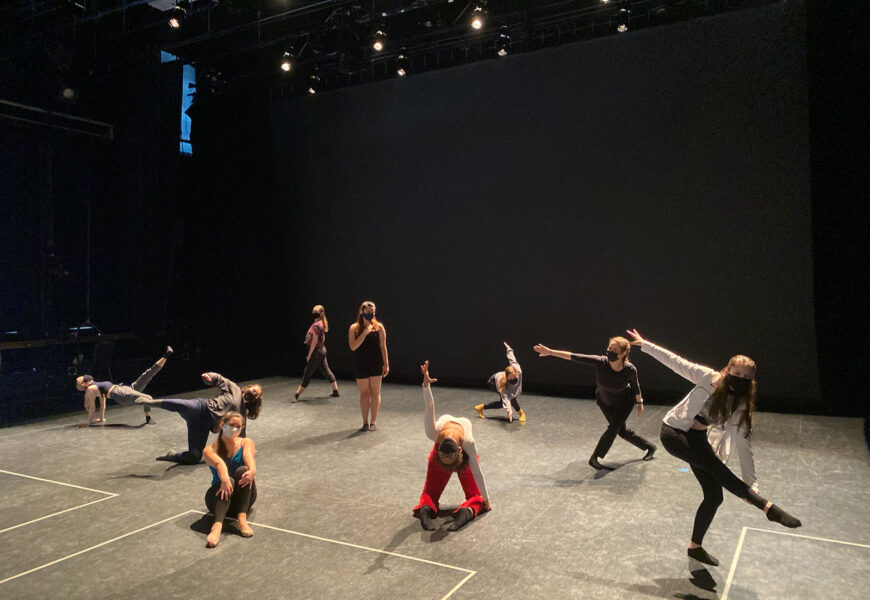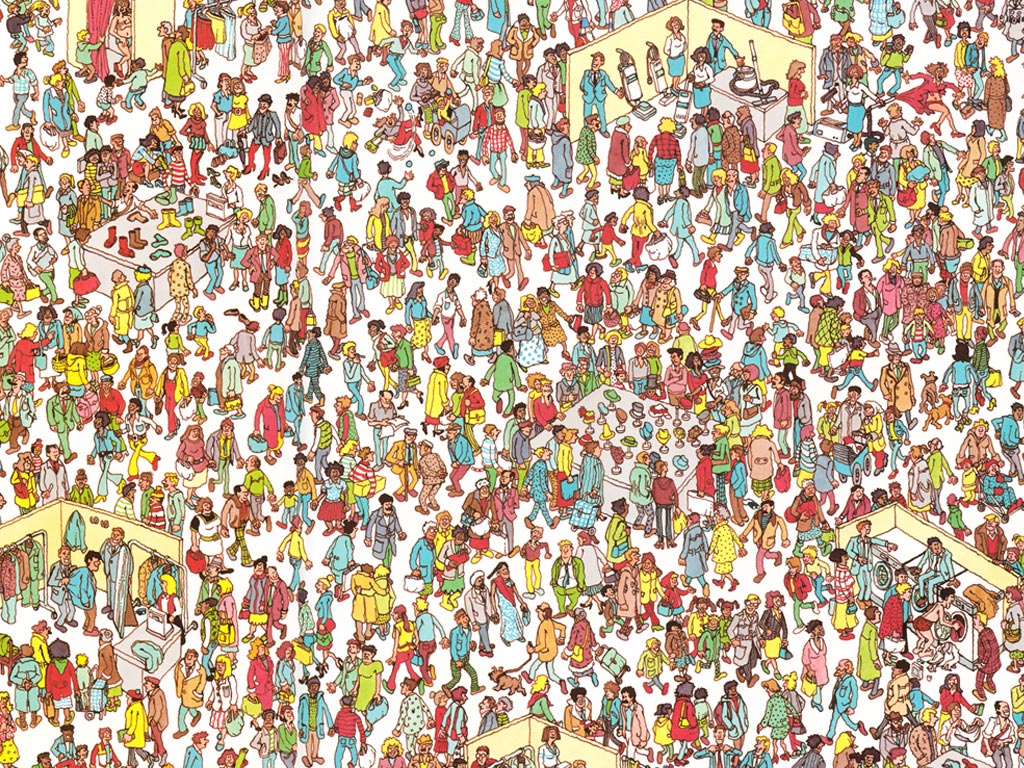Photo courtesy of Catja Christensen.
Nine student-choreographers took to the virtual stage on Sunday, March 14 to perform faculty-adjudicated solos in the inaugural installment of the “Embodied Exploration” student choreography series. Laura Beckius ‘24, Brielle Blood ‘24, Maddie Duval ‘24, Jocelyn Lewis ‘24, Maddie Oliver ‘24, Susanna Procario-Foley ‘23, Lexi Robertson ‘23, Elisabeth Wales ‘22, and I rehearsed over the past month, participating in weekly feedback sessions with Dance Department faculty and guest artist Tatiana Desardouin of Passion Fruit Dance.
The series was created with three goals in mind: to foster the culture of dance as research, to support a body of dance that spans the interests of the student population, and to receive feedback from multiple perspectives throughout the dance-making process. The dancers were instructed to explore their chosen embodied research through movement practice, experimentation, and choreography between feedback sessions. In each session, the dancers explained their concept and performed one by one in front of the professors, who were projected onto a screen in Myers Studio. For Duval, these feedback sessions were the main reason we decided to participate. “It was a great opportunity to hear from all the professors in a one-on-one way that you can’t always get in a dance class,” she said. The solos were conducive for social distancing as dancers and observers did not have to risk being near each other during feedback showings. This also allowed dancers to use the whole studio space without worrying about getting too close. Not only did the students incorporate the faculty feedback, but they also collaborated to share ideas, give support and constructive criticism, and rehearse together whenever studio space was available.
The movement styles represented were influenced by modern and postmodern dance, jazz, contemporary ballet, and lyrical/commercial dance. The solo choreographic process allowed the dancers to experiment with how their individual bodies can move, informed by various technique classes and improv prompts. No two dances were alike, as the students had freedom in every aspect of the creative process, including with music, costuming, and props. Each dancer brought their diverse backgrounds of training and experience which fostered an organic fusion of movement.
Professors David Dorfman and Rachel Boggia were also integral members of the process, hosting the feedback sessions in turns. “[The sessions] were lively, supportive, gut oriented, rapid-fire, honest, and I think super helpful,” Dorfman said. “I’m so glad we started this program… so much incredible work can happen in such a short time.” Boggia expressed that she felt “inspired” and “honored” to work with the students. As a facilitator for the first two sessions, she based the feedback structure on choreographer Liz Lerman’s Critical Response method structure, which incorporates observation, questions from both observers and performers, and shared opinions in the critique process. “I loved watching the dances change and grow,” she reflected. “It was fun to see the feedback incorporated, but even more amazing when students gave great reasons for not going the way we had suggested. The whole point is for them to find their artistic path.” Department musician Richard Schenk and Professor Martha Tornay also joined the feedback panel. The sessions were held on Wednesday evenings from 7-9 p.m., and the dancers were able to dance in Myers after the onboarding quarantine period ended. All of the faculty participated in the discussions via Zoom, except for Professor Shawn Hove who was present to set up the cameras and organized the space in Myers.
After four weeks of work, the two Sunday shows at 2 p.m. and 7 p.m. were live-streamed on Zoom, allowing remote students, faculty, family, and friends to watch the dancers perform in Myers. A large screen faced the performers to allow the Zoom squares to act as the audience. Duval says that she “barely noticed the camera” and “it felt like a real performance on a real stage, especially with all the lighting we were able to do.” Professor Lisa Race, Acting Chair of the Department, introduced each show, speaking in-person for the matinee and on Zoom in the evening. The only people in the studio were the dancers, production class students, and Professor Hove; each person remained distanced throughout warm-up, set-up, and performance. Even without a large in-person audience, Race says, “All of this was so very pleasing to see, and to take part in, since the soloists and crew were also the live audience supporting one another.” Masks became part of the costuming as dancers coordinated them with their outfits. Professor Rosemarie Roberts generously provided plastic mask breathing brackets to prevent the fabric from being uncomfortably sucked in while heavily breathing.
Professor Hove designed the lighting, scheduled sound and music cues, and set up the dual camera angles to construct an immersive, professional experience for online viewers. Lewis, Haley Michel ‘24, and Zoe Zitner ‘24 ran lighting and sound cues while Elisa Kennedy ‘21 and Ayana Sequira ‘21 assisted as House Manager and videographer on Zoom. The production was truly a student-faculty collaboration in every aspect. Students were both performers and tech crew, working together to transform the studio into a stage. Unlike the Fall semester outdoor faculty shows in the Arboretum and the Dance Club film festival, the solo show was the first production this school year that was hosted indoors and involved lighting, live-streaming, and typical production crew tasks. The tech week rehearsals and indoor performance space brought back a sense of normalcy and nostalgia for the shows in Myers last year. It had been over a year since the last in-studio performances; the Dance Club show “You and Me” was held just over a week before students left campus for spring break in March and COVID shuttered the College for months. Tears of joy and gratitude were shed as the dancers waved to the Zoom audience at the end of each show, and the chat feature was flooded with supportive, loving messages. For some, this was the first time their families had seen them perform live at Conn. For the first-years, this was their first taste of a nearly full-scale Dance Department technical production. “A year after all of my Spring performances were canceled, I am so grateful to be back performing under the stage lights,” says Beckius. “My favorite part was getting to see the virtual audience on-screen while I danced. It made the experience feel as real as possible in the current circumstances.”
With the success of this process, the upcoming Senior Capstone, Eclipse, and faculty repertory choreographies will continue rehearsing with confidence and innovation. Sequira says, “I feel so much more confident about the possibilities for sharing dance to the Conn community and far beyond. I feel like the process ran very smoothly, and although everyone couldn’t be in the space, there was still an energy that I felt even through the zoom screen.” Although the current situation is not ideal, and the Department eagerly awaits a time when they can dance closer than six-feet apart for an in-person audience, the dancers and professors are proving that they can prosper safely and successfully. With the outdoor stage soon to be constructed on Tempel Green and several student-choreographers working on dance film projects, the spring season will be filled with several opportunities to catch a show and celebrate how the arts are thriving in adversity.
A recording of the show can be found on this website starting next week: https://sites.google.com/conncoll.edu/studentsoloconcert/about?authuser=0.









